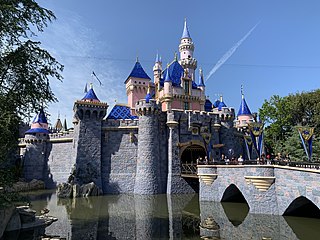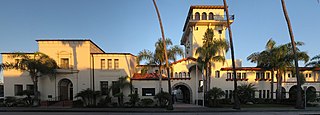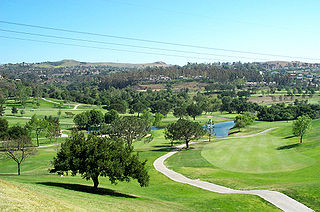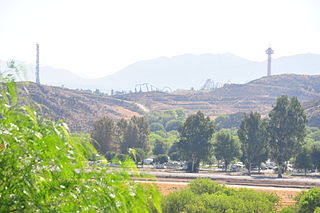
Orange County is a county located in the Los Angeles metropolitan area in Southern California, United States. As of the 2020 census, the population was 3,186,989, making it the third-most-populous county in California, the sixth-most-populous in the United States, and more populous than 19 American states and Washington, D.C. Although largely suburban, it is the second-most-densely-populated county in the state behind San Francisco County. The county's three most-populous cities are Anaheim, Santa Ana, and Irvine, each of which has a population exceeding 300,000. Santa Ana is also the county seat. Six cities in Orange County are on the Pacific coast: Seal Beach, Huntington Beach, Newport Beach, Laguna Beach, Dana Point, and San Clemente.

Anaheim is a city in northern Orange County, California, United States, part of the Greater Los Angeles area. As of the 2020 census, the city had a population of 346,824, making it the most populous city in Orange County, the tenth-most populous city in California, and the 55th-most populous city in the United States. The second largest city in Orange County in terms of land area, Anaheim is known for being the home of the Disneyland Resort, the Anaheim Convention Center, and two professional sports teams: the Los Angeles Angels of Major League Baseball (MLB) and the Anaheim Ducks of the National Hockey League (NHL). It also served as the home of the Los Angeles Rams of the National Football League (NFL) from 1980 through 1994.

Seal Beach is a coastal city in Orange County, California, United States. As of the 2020 census, the population was 25,242, up from 24,168 at the 2010 census.

Yorba Linda is a suburban city in northeastern Orange County, California, United States, approximately 37 miles (60 km) southeast of Downtown Los Angeles. It is part of the Los Angeles metropolitan area, and had a population of 68,336 at the 2020 census.

The Great Park is a public park located in Irvine, California, with a focus on sports, agriculture, and the arts. It is a non-aviation reuse of the decommissioned Marine Corps Air Station (MCAS) El Toro. The Orange County park comprises 28.8% of the total area that once made up the air base. The project was approved by the voters of Orange County in 2002 at $1.1 billion.
A county island is a small or large portion of an unincorporated area that is within the jurisdiction of a county, usually surrounded by adjacent areas that are incorporated into a municipality. On maps, these geopolitical anomalies will form jagged or complex borders and 'holes' in the city limits. Generally found more frequently in the western United States, county islands form in areas of expansion when previously smaller cities will annex and incorporate more land into their jurisdiction. If residents or landowners in a particular unincorporated area do not vote to incorporate with the surrounding city, the area remains unincorporated. The formation of a county island usually follows stages where it will come into being on the edge of an incorporated area, and as more territory is incorporated, be cut off from the rest of the unincorporated area within the county. These areas are not actually exclaves by definition, because they are simply unincorporated outside of a surrounding city.

The Orange County Register is a paid daily newspaper published in California. The Register, published in Orange County, California, is owned by the private equity firm Alden Global Capital via its Digital First Media News subsidiaries.
Atwood is a small predominantly Mexican-American neighborhood in Placentia, California. Atwood's unofficial boundaries are defined roughly as the area of Placentia in the square formed by Orangethorpe Avenue, Van Buren Street, Lakeview Road, and Miraloma Avenue. There is a post office in Atwood with a ZIP code of 92811. However, this ZIP code is only used for PO boxes. All non-PO box addresses in Atwood are listed as "Placentia" by the United States Postal Service.

Midway City is an unincorporated community and census-designated place (CDP) that forms part of the county land controlled by Orange County, California. The only area in Orange County that incorporates its chamber of commerce and homeowners association to act in concert like a city council, the area mostly is surrounded by Westminster with Huntington Beach bordering it on the southwest. Midway City was so named because it is horizontally midway between Seal Beach, to the west, and Santa Ana, to the east. The 2010 census listed the population as 8,485.

The Platinum Triangle is a district of Anaheim, California, United States, that is undergoing transformation from a low-density commercial and industrial zone into a more urban environment with high-density housing, commercial office towers, and retail space. The 820 acres (330 ha) area undergoing this large-scale redevelopment includes the city's two major sports venues, the Honda Center and Angel Stadium of Anaheim.
Little Arabia is an ethnic enclave in western Anaheim, California, the center for Orange County's Arab Americans, who number more than 24,000. It has been referred to as "Little Gaza" which was a riff on the nearby Garza Island neighborhoods. Little Arabia grew significantly in the 1990s with the arrival of immigrants from the Middle East, and is the home to thousands of Arab Americans predominantly hailing from Egypt, Syria, Palestine, and Yemen.

Anaheim Hills is a planned community encompassing the eastern portions of the city of Anaheim, in Orange County, California.
West Anaheim is a district in Anaheim, California which extends from Euclid Street on the East to the city limits at Cypress on the West. West Anaheim is where most of the residential development occurred during the 1950s and the 1960s, after Disneyland opened in 1955.

The Anaheim Regional Transportation Intermodal Center (ARTIC) is an intermodal transit center in Anaheim, California, United States. It serves as a train station for Amtrak intercity rail and Metrolink commuter rail, as well as a bus station used by the Orange County Transportation Authority (OCTA), Anaheim Resort Transportation (ART), Greyhound, Megabus, Flixbus and Tres Estrellas de Oro.

Rossmoor is a planned census-designated place located in Orange County, California. As of the 2020 census, the CDP had a total population of 10,625 up from the 2010 census population of 10,244. The gated Leisure World retirement community in the city of Seal Beach is to the south of Rossmoor, Los Alamitos is to the east and north, and Long Beach is to the west. The community of Rossmoor has two shopping centers within its boundaries, but only one—the Rossmoor Village Square, is now within the political boundaries of Rossmoor. A larger shopping center, the Rossmoor Business Center, was annexed, despite many protests, by the City of Seal Beach in 1967. The Center has been remodeled several times and was renamed the Shops at Rossmoor in the early 2000s.

Valencia is an unincorporated community in northwestern Los Angeles County, California, United States. The area, west of Interstate 5, is expanding with residential development and already includes major commercial and industrial parks. It straddles State Route 126 and the Santa Clara River.
The Orange County Local Agency Formation Commission, or OC LAFCO, is a government agency that makes decisions regarding boundaries for cities, unincorporated territory and special districts within Orange County, California. Orange County LAFCO offices are located in Santa Ana, California.
The Anaheim police shootings and protests of July 2012 involve two fatal shootings by police officers in Anaheim, California, and subsequent public protests. On July 21, Manuel Diaz was shot and killed by Anaheim Police officer Nick Bennallack after he ran from the officers. Protests ensued after the shooting. On July 22, Joel Acevedo was shot and killed by Anaheim police in an alleged exchange of gunfire, making the seventh fatal shooting by an officer in Anaheim in twelve months. Both shootings were ruled justified by the Orange County District Attorney's Office, but a federal jury later found Officer Bennallack guilty of excessive force.
The OC Streetcar is a modern streetcar line currently under construction in Orange County, California, running through the cities of Santa Ana and Garden Grove. The electric-powered streetcar will be operated by the Orange County Transportation Authority (OCTA), and will serve ten stops in each direction along its 4.15-mile (6.68 km) route.

Anaheim Rapid Connection (ARC) was a proposed streetcar line in Anaheim, California. It would have been located in the Anaheim Resort and Platinum Triangle, with stops at the Disneyland Resort, the Anaheim Convention Center, and the Anaheim Regional Transportation Intermodal Center (ARTIC), among others. It has been the subject of much political controversy, which led to the project being cancelled by OCTA in 2018. Councilmembers from the cities of Anaheim and Fullerton stated opposition to the streetcar mode citing concerns about traffic impacts, safety, capital costs, and recent declining transit ridership. These cities also shared concerns about how implementation of dedicated transit lanes would impact automobile traffic.














